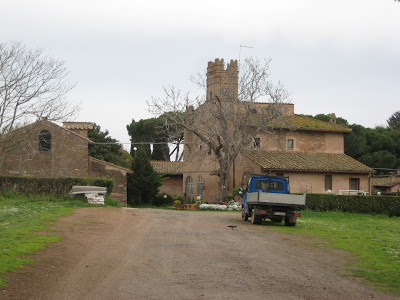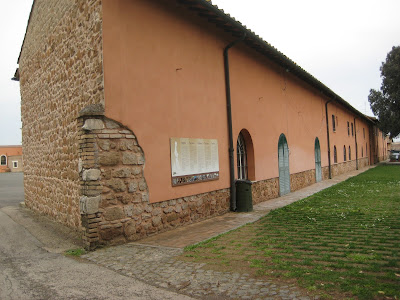The Catacombs of St. Callixtus
Cool plexiglass roofed old houses pepper the Roman countryside and roads. What are they?
They are called "lucernaio" and indicate that there is a catacomb below. They once shone light into the dark musty catacombs and also provided fresh air. A sky light if you will. There are over 77 catacombs in Rome holding an estimated 500,000 bodies. Only 6 of those catacombs are open for the public, however. The Roman tradition for burial was cremation where the bodies of dead would be burned. Early Christians believed that the entire body needed to be buried so that when Christ returned their bodies would be lifted from the grave and taken with Him to Heaven. Burial was illegal at that time so it took just over 100 years for Christians to get permission and purchase land to bury their dead. The early Christians were brave, really brave. They faced death for their faith in Christ. They invented hospitals against the belief that the sick should be abandoned. Really, hospitals were started by early Christians beginning in 325 AD after this vital meeting called the Council of Nicaea. During that meeting the many issues on the basis of Christianity were discussed and one of them were hospitals, taking care of the sick as Christ would do. After that meeting, Catholics built a hospital every time they built a church. The word hospitality derives from the latin root hospes meaning 'stranger' and 'guest'. Ahhh...I got a degree in English for something!
Anyways, so we wanted to see the Catacombs of St. Callixtus because it is one of the most important catacombs of Rome. Why? Well, it buries Christian martyrs who were killed in brutal ways for their faith. One famous martyr being St. Cecilia who was killed at the ripe old age of 13. She was truly brave. Her father had her marry this guy, Valerian (like the root), she knew she was meant to live a holy life married to God so she requested not to have sex with him. He saw her truthfulness, became a Christian (was killed after she was). So St. Cecilia's dad didn't like her attitude, snitched on her to the Christian hunters working for emperor Marcus Aurelius and they came to kill her. First they tried to smother her, but she didn't die, then they cut her throat and she bled and bled but wouldn't die. She sang as she bled, poor little dear. She begged for the Eucharist (the body of Christ) and it was finally given to her. He throat was cut one more time and she died singing to God as she faded away holding out three fingers as a sign of her faith (the trinity: Father, Son, Holy Ghost). Now that is faith and bravery. Her body is incorruptible meaning it won't decompose. St. Callixtus also is the resting place for nine popes. In fact, it is the official cemetery for the Church of Rome.
I loved going to the catacombs. St. Callixtus is 92 acres large and is considered Sacred ground.
The opening hours are from 9 AM - 12 PM then riposo. And they reopen at 2 PM. The catacombs are managed by Franciscan friars, I think. Anyway, we took the train into the city, then the metro, then a bus and finally made it to St. Callixtus.
 |
| the back seat of the bus here is identical to buses in Baltimore, NYC, Mexico City and DC |
 |
| Here we are |
The feeling there was clean. Pure clean. The air was fresh, the trees cheery, the birds chirpy and the entire grounds breathed joy.
 |
| One of the entrances |
We got there around 1 PM so had some time to walk around the gardens and hills of the catacombs.
 |
| airy, light, peaceful |
 |
| the home of the groundskeeper |
 |
| the three sisters |
Via Appia, or Appian Way is the most important and old Roman road. It spans most of southern Italy and was used by the Romans to travel in and out of the city. This road has seen a huge amount of history. In 73 BC a soldier named Sparticus defeated the Roman army then made the mistake to march his troops home on the Appian Way. The angry Romans came after him and crucified him and his 6,000 men along Via Appia. Then in 1944 the Allies got entrapped in the same road. The Germans came after then and a four long month battle ensued. During that time the Germans took all Jews they could find in Rome and slaughtered them along the path. So the Appian Way, on the outskirts of the Catacombs has been bathed in blood.
Back to the catacombs. We enjoyed walking the grounds for a good hour before our tour began.
 |
| The grounds are considered sacred. |
 |
| a recent house. Probably built in the 15th century. You know, modern. |
We saw a little rocky nook and decided to peek in. There was a sweet statue of our Mother Mary over a pond of bright fat orange fish.
 |
| "plese do not feed bread to the fish" I guess the fishies are on a low carb diet....fat fishies |
 |
| No bread for you, Chunky! |
 |
| Another modern building. |
 |
| Some little kids were frolicking and dropped this perfect crown of daisies and dandelions. |
 |
| The franciscan friars live here |
 |
| The church for the friars |
 |
| Under this field lay thousands and thousands of Christian martyrs in catacombs. |
At 2 PM we got ready for the tour. The priest opened up with prayer then separated the tourist groups into language groups, we chose the Italian group because it was the smallest and the priest was really excited so we knew this was his thing and he would be much better than the Polish girl who was matter-of-factly stating her knowledge in English.
The catacombs don't allow pictures so I didn't take any down there out of respect since it is a sacred site. I loved descending into the tombs of early Christians. down we went into a narrow passage that was maybe 2 feet wide and 50 feet deep. There were once marble closures for each tomb. The marble had etched art of telling the belief of Christianity. These were made before the New Testament was written. Before! That is like a million years ago! Well, more like 1600 years but still a long time. The etchings show a shepherd carrying a sheep (Christ is the good shepherd , then there are two fishes for the parable of Jesus feeding the crowd and being a fisher of men, there are also frescos of Jesus distributing the first Eucharist at the last dinner with the 12 Apostles. All of these symbols were the door to the graves of Christians who died for their faith. I can't even wrap my head around that. Died for their faith! They were so brave to believe in Christ knowing that they could be fed to lions. In a day where wearing a bikini to the beach is considered brave and being a Christian is mixed in with accepting all garbage it is hard to believe that there was a time when people were fed to lions for believing in Christ.
After the tour the sky darkened threatening rain so we headed off to the bus stop and waited forever for the number 218 bus to come pick us up.
Figuring out how to get back. Finally after an hour, the bus came and we headed off like cattle (it was really full) back into the city of Rome.
I left really impressed by the catacombs. The enormous faith and bravery the early Christians had left me marveling at their nerve to stand up and believe in Christ knowing they would be killed. None of those martyrs wondered if Christ existed or the theology of Him or questioned his greatness. They just believed purely, fiercely and really had faith in God. I was also amazed that over 40% of the martyred bodies were children under the age of 13. You know how they say that kids say the truth? Well, I think I have a lot to learn from those little heroes.























That is absolutely unreal that so many of the martyrs during that time were children...I had no idea! I'd never heard the story of St. Cecilia either...what a brave and faith-filled young woman. Makes you really think of all we take for granted.
ReplyDelete